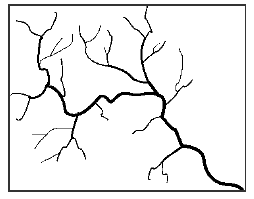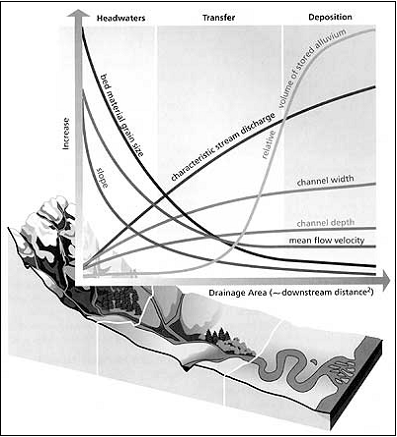Water: Middle School
Exercise V. Stream Order and the Physical Structure of Streams
Stream Order
Visit the Exploring the Environment Web page on Water Quality (http: //www .cotf .edu /ete /modules /waterq /wqphys methods .html
) and answer the following questions.

1. What is stream order?
2. Determine the order of streams on the stream network picture to the right. Indicate stream order by writing a 1, 2, 3, 4, or 5.
3. Look at the pictures of a first-, second-, third-, and fourth- order stream at the bottom of the Web page. Fill out the chart comparing the stream types.
| Comparing Stream Order | ||||
|---|---|---|---|---|
| Stream Order | First-Order | Second-Order | Third-Order | Fourth-Order |
| Shade (full, partial, or no shade) |
|
|
|
|
| Width (narrow, very narrow, wide, very wide) |
|
|
|
|
| Shape(straight, curvy) |
|
|
|
|
Physical Structure
Look at the chart you filled out above. This chart looks at some ways streams change as they combine and form larger and larger rivers. Visit the Minnesota Shoreline Management Web page (http://www.shorelandmanagement.org/depth/rivers/02.html) and read about how a stream's structure changes as it flows from its headwaters to its outlet.
After reading the article, take some time to look at the graph "Three Longitudinal Zones and Channel Characteristics." Answer the questions about how a stream changes as it flows down its course.
Three Longitudinal Zones and Channel Characteristics

Terms
- Bed material grain size:
- The size of the rocks, sand, and dirt that make up the bottom of the stream.
- Channel depth:
- A measure of how deep the stream is.
- Channel width:
- A measure of how wide the stream is.
- Drainage area:
- The amount of land from which a stream gets its water.
- Mean flow velocity:
- The average speed at which water moves in a stream.
- Slope:
- How steep the land is where the stream is flowing.
- Stream discharge:
- The amount of water in a stream.
1. What are the three river zones represented on the graph?
2. In what zone would you probably find a first-order stream? What about a second-, third-, and fourth order stream?
3. On the horizontal axis, label where you think each order of stream is most likely to be found.
4. As stream order increases, what happens to the drainage area of the stream?
5. As stream order increases, what happens to the slope of the stream?
6. As stream order increases, what happens to the speed at which water flows in a stream?
7. As stream order increases, what happens to the width of the stream?
8. As stream order increases, what happens to the amount of water in a stream?
9. As stream order increases, what happens to the stream's channel depth?
Middle Schools | Whatzzzup_Stream? | Exercises: I | II | III | IV | V | VI | Top
